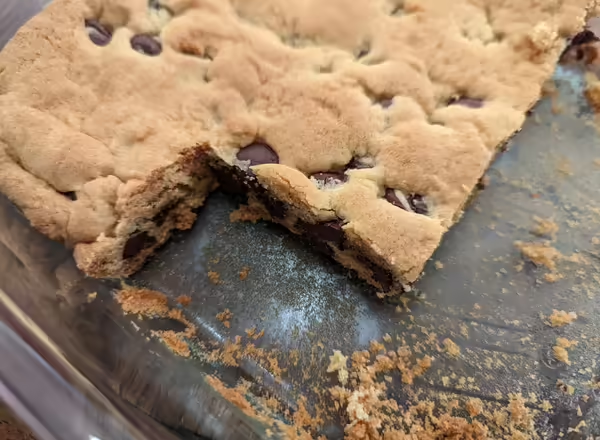
A few things happened that day I wanted to make cookies.
- I didn't want to make individual cookies - or multiple dozens of cookies. (Too much time waiting on batches.)
- The dietitian in me wanted to add in a boost of nutrition. (But not make the cookies so "healthy" as to remove satisfaction.)
- The amateur recipe developer in me wanted to see what could happen. (Because food experimenting is fun!)
So, enter a cookie recipe turned cookie bar recipe. More on that later.
Ingredient Substitutions
Sometimes you don't have an ingredient when you need it. Fortunately, cooks and bakers have found ways to use other ingredients in place of the one that's missing. Most of the time, the substitution will be close enough that anyone eating the recipe will not notice a difference. For example, if you don't have 1 teaspoon of baking powder, try ¼ teaspoon baking soda plus 5/8 teaspoon cream of tartar (5/8 teaspoon is the same as ½ teaspoon plus 1⁄8 teaspoon).
Adapting Recipes
Besides not having an ingredient, home cooks make intentional swap for health and food allergy reasons. You might also adapt a recipe based on what's available at a certain time of year, what's cost-effective for your food budget, or what's carried at your local store. Or, maybe you're trying to adapt an oven recipe to make in your slow cooker or electric pressure cooker.
Make one change at a time
Plan to make the recipe more than once, making a single change each time. If the recipe comes out with an odd color, flavor, or texture, and you made multiple swaps, it will be hard to know what swap caused the problem.
Read about time-tested swaps
Humans have been cooking and baking for a long time, and we have recommendations after lots of practice. For example, a common swap to reduce sugar in a cookie or muffin recipe is to reduce the sugar by up to half. To reduce fat, substitute half of the fat or oil in a cake with applesauce. Cooperative Extensions across the country have lots of recommendations on ingredient substitutes and ways to adapt recipes. Search for your state at extension.org/search.
Write it down
When you go to make the recipe again, it's easy to forget what you did the last time. Having the changed measurements, oven temperatures, or cooking times written down will help you prepare for future swaps.
It is okay to fail
After making swaps, I've had recipe turn out from "just okay" to "nope, never doing that again." When the recipe doesn't turn out as expected, I'm sure you can understand my frustrations. Maybe you've felt that way too. The waste of ingredients. All the time spent. But when I notice that frustration, I practice turning my attention to learning from the experience. I won't do that same thing next time and that feel empowering.
Adapting Cookies to Cookie Bars: My Steps
From the original cookie recipe, I made a half batch. From that list of ingredients, I started making swaps. Here's what I did:
- ↑ fiber: swap half of the all-purpose flour with whole-wheat flour
- ↓ saturated fat: reduce butter by a tablespoon, replace shortening (not recommended if making individual cookies)
- ↑ unsaturated fat: replace shortening with liquid oil (test 1)
- ↓ total fat: reduce oil by a tablespoon (test 2)
- ↓ sugar: reduce sugar by half (test 1), reduce brown sugar by another couple tablespoons (test 2)
- ↓ sodium: reduce salt by 1/8 teaspoon
- - vanilla extract: I don't keep a bottle in my kitchen, so I didn't use it
- x corn syrup: I don't keep a bottle in my kitchen, so I swapped it for honey
I really like what these swaps created. The cookie bars have a tender crumb, are lightly sweet, and taste better after a couple days. Plus, they are freezer-friendly!
If you make this recipe, take a picture and tag Illinois Extension on Facebook, Instagram, or Twitter.
About the Author: Caitlin Mellendorf is an Illinois Extension Nutrition and Wellness Educator serving DeWitt, Macon and Piatt Counties in Central Illinois. She is a Registered Dietitian and her work focuses on helping community members gain the knowledge, skills and tools to live healthier, more nutritious lifestyles. This includes providing programs and answering questions about heart health, diabetes, food safety, food preservation, grocery shopping and cooking. You can reach Caitlin by email at chuth2@illinois.edu or call 217.877.6042.
